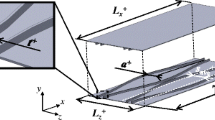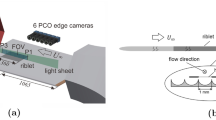Abstract
The drag-reduction effect of a three-dimensional sinusoidal riblet surface is experimentally evaluated in a fully developed turbulent channel flow. The lateral spacing of the adjacent walls of the riblet is varied sinusoidally in the streamwise direction. The obtained maximum total drag-reduction rate is approximately 12 % at a bulk Reynolds number of 3,400. The flow structure over the sinusoidal riblet surface is also analyzed in the velocity field by using two-dimensional particle image velocimetry. The velocity field is compared with the corresponding flow over a flat surface. It is found through pathlines and Reynolds shear stress analyses that the drag-reduction mechanism is similar to those of two-dimensional riblets. A different point is that the present riblet respectively induces a downward and upward flows in the expanded and contracted regions, which prevent vortices from hitting the bottom wall with wider lateral spacing of the riblet. In consequence, the wetted area of the present sinusoidal riblet is smaller than those of two-dimensional riblets, resulting in the high drag-reduction effect.



















Similar content being viewed by others
Abbreviations
- \(x\) :
-
Position in the streamwise direction (m)
- \(y\) :
-
Position in the wall-normal direction (m)
- \(z\) :
-
Position in the spanwise direction (m)
- \(u\) :
-
Streamwise velocity (m/s)
- \(v\) :
-
Wall-normal velocity (m/s)
- \(w\) :
-
Spanwise velocity (m/s)
- \(\delta\) :
-
Channel half-width (m)
- \({\hbox{d}}p\) :
-
Differential pressure (Pa)
- \(\nu\) :
-
Kinematic viscosity (\(\hbox {m}^2/\hbox {s}\))
- \(\rho\) :
-
Density (\(\hbox {kg/m}^3\))
- \(Q\) :
-
Mass flow rate (\(\hbox {m}^3/\hbox {s}\))
- \(L_z\) :
-
Channel spanwise width (m)
- \(C_{\mathrm{T}}\) :
-
Total drag coefficient
- \(D_{\mathrm{P}}\) :
-
Pressure drag on the riblet (Pa)
- \(R_{\mathrm{D}}\) :
-
Drag-reduction rate (%)
- \(l_t\) :
-
Riblet thickness (m)
- \(h\) :
-
Height of riblet wall (m)
- \(l\) :
-
Distance between pressure taps (m)
- \(L_p\) :
-
Distance of the center position between pressure taps from the beginning of the test section (m)
- \(l_{x}\) :
-
Streamwise length of one cycle of the riblet (m)
- \(l_{z}\) :
-
Lateral spacing of the riblet (m)
- \(S\) :
-
Wetted area (\(\hbox {m}^2\))
- \(u_{b}\) :
-
bulk velocity (m/s) (=\(\frac{1}{2\delta }\int ^{2\delta }_0 \overline{u(y)}{\hbox{d}}y\))
- \(\mu\) :
-
Viscosity (\(\hbox {Pa}\,\hbox {s}\))
- \(\tau _{w}\) :
-
Wall shear stress (\(\hbox {N/m}^2\)) (=\(\mu {\hbox{d}}\overline{u}/{\hbox{d}}y_{\mathrm{wall}}\))
- \(u_{\tau }\) :
-
Friction velocity (\(\hbox {m/s}^2\)) (\(= \sqrt{\tau _{w, \,{\mathrm{flat}}}/\rho }\))
- \(Re_{\tau }\) :
-
Friction Reynolds number (–) (=\(u_{\tau , \,{\mathrm{flat}}} \delta / \nu\))
- \(Re_{b}\) :
-
Bulk Reynolds number (–) (=\(u_b 2\delta / \nu\))
- \(B_{i}\) :
-
Event probability of quadrant
- \(\omega _{z}\) :
-
Spanwise vorticity (1/s)
- \(t\) :
-
Time (s)
- \(T\) :
-
Measurement time (s)
- \(()^{+}\) :
-
Non-dimensionalization by \(u_{\tau , \,{\mathrm{flat}}}\) and \(\nu\) (wall-unit)
- \(()^\prime\) :
-
Fluctuation from the spatiotemporal average
- \(()^{\prime \prime }\) :
-
Fluctuation from time average (random component)
- \(( ),_{\, {\mathrm{flat}}}\) :
-
Experimental result for flat-flat case (both side walls are flat surface)
- \(( ),_{\, {\mathrm{rib}}}\) :
-
Experimental result for flat-riblet case (riblet boards are installed on a lower wall)
- \(( ),_{\, {\text {2-D}}}\) :
-
Result for a 2-D riblet surface
- \(( ),_{\, {\text {3-D}}}\) :
-
Result for a 3-D riblet surface
- \(()_{i}\) :
-
Direction or quadrant
- \(\overline{( )}\) :
-
Average over time
- \(\langle \rangle\) :
-
Average over space
- \(\widetilde{( )}\) :
-
Periodic fluctuation
References
ANSI/ASME (1987) Measurement uncertainty, supplement on instruments and apparatus
Bechert DW, Bartenwerfer M (1989) The viscous flow in surface with longitudinal ribs. J Fluid Mech 206:105–129
Bechert DW, Bruse M, Hage W, Vanderhoeven JGT, Hoppe G (1997) Experiments on drag-reducing surfaces and their optimization with an adjustable geometry. J Fluid Mech 338:59–87
Bechert DW, Bruse M, Hage W, Meyer R (2000) Fluid mechanics of biological surface and their technological application. Naturwissenschaften 87:157–171
Choi H, Moin P, Kim J (1993) Direct numerical simulation of turbulent flow over riblets. J Fluid Mech 225:503–539
Choi KS (1989) Near-wall structure of a turbulent boundary layer with riblets. J Fluid Mech 208:417–458
Choi KS, Graham M (1998) Drag-reduction of turbulent pipe flows by circular-wall oscillation. Phys Fluids 10(1):7–9
Dean RB (1978) Reynolds number dependence of skin friction and other bulk flow variables in two-dimensional rectangular duct flow. ASME J Fluid Eng 100:215–232
Fukagata K, Iwamoto K, Kasagi N (2002) Contribution of reynolds stress distribution to the skin friction in wall-bounded flows. Phys Fluids 14(L73):4
Hussain AKMF, Reynolds WC (1970) The mechanics of an organized wave in turbulent shear flow. J Fluid Mech 41:241–258
Iwamoto K, Suzuki Y, Kasagi N (2002) Reynolds number effect on wall turbulence: toward effective feedback control. Int J Heat Fluid Flow 23:678–689
Iwamoto K, Fukagata K, Kasagi N, Suzuki Y (2005) Friction drag-reduction achievable by near-wall turbulence manipulation at high reynolds numbers. Phys Fluids 17(011702):4
Lu SS, Willmarth WW (1973) Measurements of the structure of the reynolds stress in a turbulent boundary layer. J Fluid Mech 60:481–511
Luchini P, Manzo F, Pozzi A (1991) Resistance of a grooved surface to parallel flow and cross-flow. J Fluid Mech 228:87–109
Mayoral GR, Jiménez J (2011) Drag-reduction by riblets. Philos Trans R Soc 369:1412–1427
Miki H, Iwamoto K, Murata A (2011) Piv analysis on a 3-dimensional riblet for drag-reduction. J Jpn Soc Mech Eng 77(782):1892–1903 (in Japanese)
Peet Y, Sagaut P (2009) Theoretical prediction of turbulent skin friction on geometrically complex surfaces. Phys Fluids 21(105105):19
Peet Y, Sagaut P, Charron Y (2008) Turbulent drag-reduction using sinusoidal riblets with triangular cross-section. In: The 38th AIAA fluid dynamics conference and exhibit (AIAA-2008-3745):9
Sha T, Itoh M, Tamano S, Akino N (2005) Experimental study on drag-reduction in turbulent flow on zigzag riblet surface. In: The 88th fluid engineering division conference of the Japan society of mechanical engineers 21(207):1 (in Japanese)
Soma A, Iwamoto K, Murata A (2009) Experimental investigation of pump control for drag-reduction in pulsating turbulent pipe flow. In: 6th International symposium on turbulence and shear flow phenomena vol 2, 761–765
Soma A, Iwamoto K, Murata A (2012) Experimental analysis of pressure-gradient profile upon drag-reduction effect in pulsating turbulent pipe flow. J Jpn Soc Mech Eng 78(787):521–530 (in Japanese)
Tanahashi M, Hirayama T, Taka S, Miyauchi T (2008) Measurement of fine scale structure in turbulence by time-resolved dual-plane stereoscopic piv. Int J Heat Fluid Flow 29:792–802
Viswanath PR (2002) Aircraft viscous drag-reduction using riblets. Prog Aerosp Sci 38:571–600
Walsh MJ (1980) Drag characteristics of v-groove and transverse curvature riblets. Symp Viscous Flow Drag Reduct 72(207):168–184
Walsh MJ (1982) Turbulent boundary layer drag-reduction using riblets. Am Inst Aeronaut Astronaut (AIAA-paper 82–0169):9
Walsh MJ (1983) Riblets as a viscous drag-reduction technique. Am Inst Aeronaut Astronaut 21:485–486
Acknowledgments
This research was partially supported by the Ministry of Education, Culture, Sports, Science and Technology through a Grant-in-Aid for Scientific Research (c), 24560186, 2012. The sinusoidal riblet plates in this research were fabricated by using a milling machine in Tokyo University of Agriculture and Technology Center of Design and Manufacturing.
Author information
Authors and Affiliations
Corresponding author
Rights and permissions
About this article
Cite this article
Sasamori, M., Mamori, H., Iwamoto, K. et al. Experimental study on drag-reduction effect due to sinusoidal riblets in turbulent channel flow. Exp Fluids 55, 1828 (2014). https://doi.org/10.1007/s00348-014-1828-z
Received:
Revised:
Accepted:
Published:
DOI: https://doi.org/10.1007/s00348-014-1828-z




